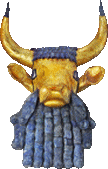| |
Lapis Lazuli
|
The name Lapis Lazuli comes from the Latin meaning "stone of azure". The traditional name for lapis is sapphrius, which is Hebrew for “sky blue stone”. This should not be confused with our modern sapphire, which is corundum.
Lapis was used to create a deep blue paint, called ultramarine, that was used in some of the most sacred art of the Renaissance period. Crushed lapis was used in medications in Medieval Europe, where it was thought to strengthen the heart and cure fever. A deep blue makeup was made from powdered lapis in early China and Egypt.
Lapis was one of the most sacred materials to many ancient peoples. In Egypt it was considered a fallen piece of the sky goddess Nuit, and prized as a charm against evil deeds and curses. The Sumerians carved cylinder seals and protective amulets from lapis. Many cultures in the Aegean and Near East wore the stone to ward off misfortune and the evil eye, and it has been argued that the glass evil eye pendants popular today may have originally been based on these lapis beads.
Early lapidaries claimed the lapis was the holiest of stones and that God looked favorably upon anyone who possessed it. In Judeo-Christian folklore Solomon engraved his seal upon lapis to create the amulet he used to gain control over demons, and the ten commandments were inscribed upon the stone. This association with divinity caused medieval Christians to imbue the stone with the ability to deliver the wearer from evil and bondage. This claim was expanded to the literal by early lapidaries, who claimed that a devout individual could unlock shackles and prison doors by simply touching the locks with a lapis.
|
Colors
|
Blue with flecks of pyrite, sometimes with white streaks
|
Locations
|
Afghanistan, Egypt, Canada, Chile, the Americas.
|
Compisition
|
(Na,Ca)8(AlSiO4)6(S,SO4,Cl)2
|
Hardness
|
5 - 6
|
|

|

|

|
|
|
|
|
|